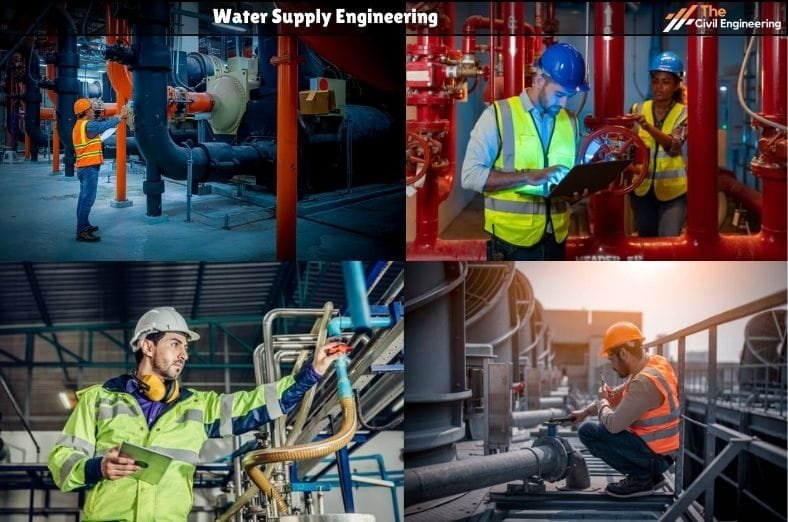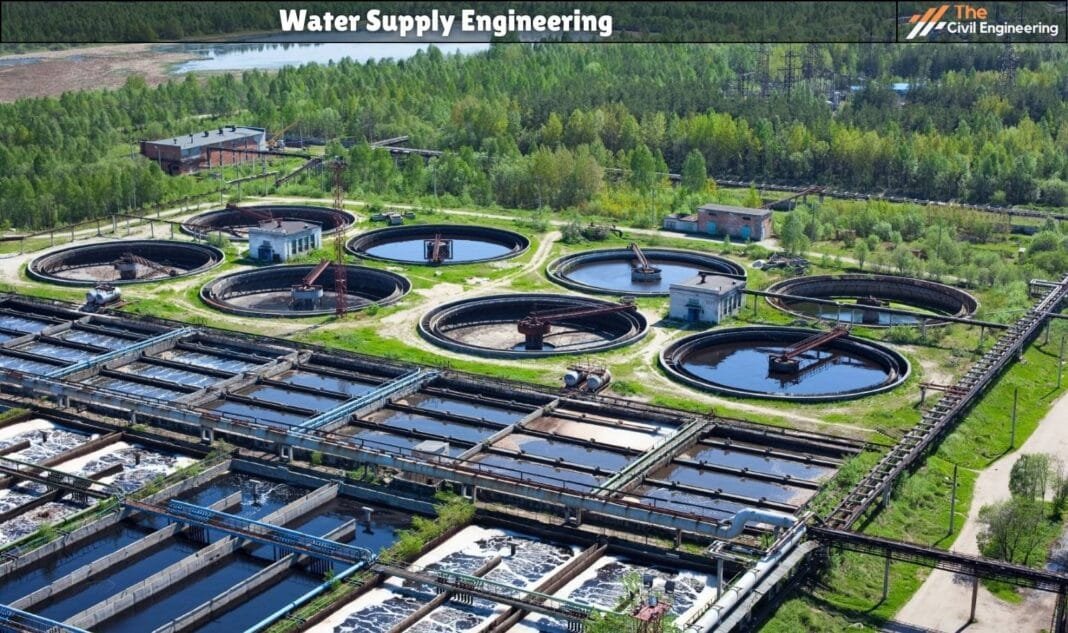Water Supply Engineering is a branch of Civil Engineering that deals with the Development of Sources of Supply, Distribution, and Treatment of water.
Water Supply Engineering helps us to supply clean water to particular cities/towns (i.e., homes).
Surface water is the type of water mainly found on the surface of the earth. Example:- Spring, Lake, River, etc.
Sub-surface water is the type of water mainly found below the earth’s surface. Groundwater is known as Subsurface water. Example: Well

Importance of Water
1. Man and animals consume water. Also, consume vegetation for their food. Plants cannot grow without water.
2. The growth of vegetation also depends upon bacterial action, while bacteria need water to thrive.
3. Good sanitation cannot be maintained without an adequate water supply system.
4. Humans need water for drinking, cooking, cleaning, and washing.
5. Water keeps an ecological balance.
6. For balancing the relationship between living things and the environment in which they live.
1. Types of Water
1.1 Potable Water
Potable water is safe enough to be consumed by humans or used with a low risk of immediate or long-term harm.
1.2 Wholesome Water
Wholesome water is pure water that does not contain any impurities. It only contains two-part Hydrogen and Oxygen by Volume.
Wholesome water is not found in water because water found in Nature contains many impurities, such as Dust particles, Gases. Even Rainwater is not included in Wholesome water because it absorbs various gases, dust, and other impurities.
It carries silt, sand, and other Dust Particles when flowing in the ground. Removing turbidity, odor, and smell is considered good, and removing dissolved substances is known as “chemically pure”. Chemically pure water is also corrosive but not wholesome water.
The following are the requirements for wholesome water.
1. It should be free from all types of bacteria.
2. It should be colorless and sparkling.
3. It should be tasty, odor-free, and cool.
4. It should not contain objectionable matters.
5. It should not corrode pipes.
6. It should have dissolved oxygen and be free from carbonic acid so that it may
remain fresh.
2. Importance of Water Supply
a. The most crucial thing in underwater supply schemes is selecting the water source, which must be long-lasting and have the least impurities.
b. After the selection of the source of water. The next step is to construct intake works to collect it and carry it up to treatment plants. At the treatment plants, this water will be treated.
c. Types of treatment processes directly depend on the impurities in water at the source and the water quality required by the consumers.
d. When the water is treated, it is stored in the clear water reservoir from where it will be distributed to the consumers.
e. The distribution system depends on the clear water reservoir’s elevation and the distribution area’s elevation.
In low-level areas, water will directly flow under gravitational force, but for high-level areas, elevated tanks or pumping will be required.
3. Advantage of Water Supply Engineering
1. In this system, water is not stagnant in the pipe at any instant; hence, freshwater is always available.
2. Lesser pipe sizes are needed.
3. Fire Hazards can be met within the time.
4. Disadvantage of Water Supply
1. Chance of water wastage and losses through the pipe.
2. More wastage of water due to lack of civic sense.
5. Water Demand
Following are the various types of water demands of a city or town:
i. Domestic water demand
ii. Industrial demand
iii. Institution and commercial demand
iv. Demand for public use
v. Five demand
vi. Loses and wastes
i. Domestic Water Demand
The amount of water required inside the homes for drinking, bathing, cooking, washing, and so forth is known as home water call and, in particular, relies upon the habits, social status, climatic situations, and customs of the people.
ii. Industrial Demand
The water required withinside the industries mainly relies upon the form of industries, which can be current withinside the city.
The water required through factories, paper mills, Cloth mills, Cotton mills, Breweries, Sugar refineries, etc., comes below commercial use. The amount of water called for commercial motive is around 20 to 25% of the whole call for the city.
iii. Institution and Commercial Demand
Examples of Institution and Commercial demand are Universities, institutions, commercial buildings, and commercial centers, including office buildings, warehouses, stores, hotels, shopping centers, health centers, schools, temples, cinema houses, railway and bus stations, etc, which come under the category.
iv. Demand for Public Use
The amount of water required for public functions, including laundry and sprinkling on roads, cleansing of sewers, watering of public parks, gardens, public fountains, and so forth, comes below the public call for.
To make the water adequate for public use, the supply of 5% of the total intake is made by designing the waterworks for a city.
v. Five Demand
The water is allocated for emergency purposes. In most cases, a fire occurs due to faulty electric wires by short-circuiting, fire-catching materials, explosions, the lousy intention of criminal people, or any other unforeseen mishappenings.
Fire can make a massive loss of life and Money if Fire is not Controlled in Time. So, enough water should be collected and stored for Emergency Purposes.
The quantity of water needed for firefighting is calculated using
different empirical formulae. For Indian conditions, the kuichings formula gives satisfactory results.
Q=3182 √p
Where ‘Q’ is the quantity of water required in liters/min
‘P’ is the population of a town or city in thousands
vi. Loses and Wastes
All the water goes into the distribution, and pipes do not reach the consumers.
The following are the reasons for water and losses of Water:-
1. The main problem of Losses is due to defective pipe joints, cracked and broken pipes, faulty valves, and fittings.
2. The Losses are due to consumers’ mistakes like keeping open their taps of public taps even when they are not using the water and allowing the continuous wastage of water.
3. The Losses due to unauthorized and illegal connections.
6. Aim of Water Supply System
A water supply system is a network of water pipelines of various diameters with control valves for carrying water and supplying water to consumers.
The aims of the water supply system are:
1. To supply wholesome water to the consumers for drinking.
2. To provide the required quantity to meet the minor requirement needs of the
individuals.
3. To make requires supplying for emergencies like fire fighting, festivals, meetings, etc.
4. To make a supply for future demands due to increased population.
5. To prevent water pollution at the source, storage, and conveyance.
6. To keep the treatment units and distribution system in good condition with
the required staff and materials.
7. To construct, design, and keep an economical and long-lasting system.
The components of a water supply system can be divided into two major parts:
1. Transmission Line or Transmission Main: Pipeline from intake to reservoir tank.
2. Distribution Line: Pipeline from the reservoir tank to the tap stand.
7. System of Water Supply
There are three systems of supply:
1. Gravity Flow System
2. Pumping System
3. Dual System
7.1 Gravity Flow System
This technology is often used in hilly, rural areas where people used to have to carry water long distances over steep terrain. Our partners tap a spring or dam a small unpolluted stream, and the water flows downhill into storage tanks.
These tanks then feed the faucet inside the community’s coronary heart. In the strength of gravity manner, there may be no want for high-priced pumps, so the general prices are low.
7.2 Pumping System
Pumping structures typically comprise one or a couple of centrifugal pumps placed in parallel.
Early PV pumping structures used constant velocity pumps pushed via electric-powered motors, and their layout and control turned appreciably simpler.
7.3 Dual System
Dual distribution structures are typically used to deliver potable water via one distribution community and non-potable water via the other.
The structures could enhance public water materials by imparting untreated or poorly treated water for functions aside from drinking. Such functions should include fire-fighting, sanitary flushing, road cleaning, or irrigation of decorative gardens or lawns.
8. Types of Water-Related Diseases
8.1 Waterborne Diseases
Water-borne diseases are caused due to drinking water contaminated with pathogenic microorganisms. One of the most common water-borne diseases is typhoid fever.
8.2 Water-based Diseases
Water-based diseases are caused by parasites found in intermediate organisms living in contaminated water.
Examples contain dracunculiasis, schistosomiasis, and other helminths. These diseases are usually passed to humans when they drink contaminated water or use it for washing.
9. Preventive Measures
1. Improve the quality of drinking water at the source, at the tap, or in the storage vessel interrupting the routes of transmission
2. Protecting food from flies interrupts the feces-flies-food route (at a household level). Water chlorination interrupts the feces-fluids-food and drinking water route (at the community level).
3. Increase the quantity of water available. This allows better hygiene and can thus prevent disease transmission from contaminated hands, food, or household utensils.
4. Care in disposing of feces.
5. Proper use and maintenance of water supply and sanitation systems.
6. Changing hygiene behavior.
7. Good food hygiene.
8. Safe and protective measures should be adopted to avoid contamination and to destroy infectious organisms while handling and disposing of infant and toddler feces.
10. References1. Content Filter & Authenticity Checking Team, The Civil Engineering (Our team checks every content & detail to maintain quality.) |
Read More: Water Distribution System
Read More: Sanitation System


